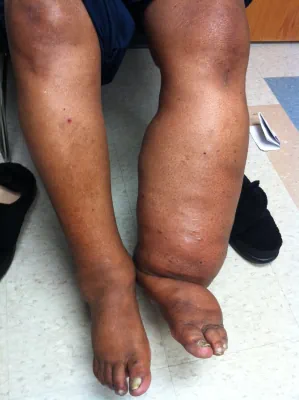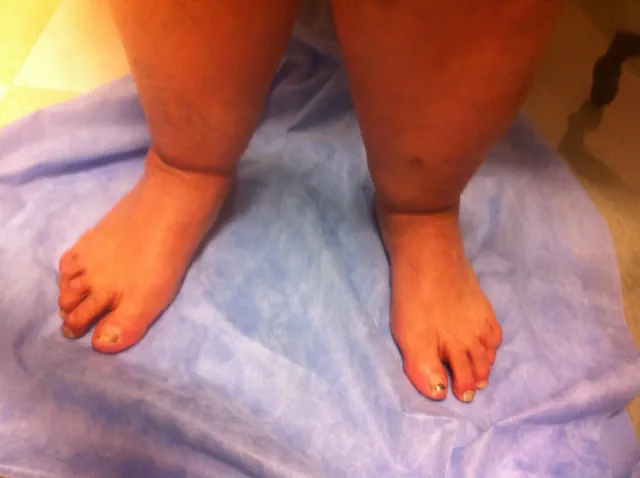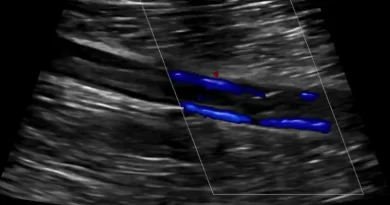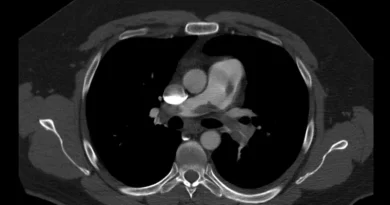One Swollen Leg
There are many possible reasons for one swollen leg. Sometimes the swelling develops quickly. But other times the swelling is chronic. Also, some causes for one swollen leg are dangerous, and others are not. Knowing the difference will direct treatment. In the following article I will first list causes of sudden swelling of one leg. Then, I will list reasons for chronic swelling.
One Swollen Leg from a Blood Clot in the Leg
If you develop one swollen leg suddenly, without an obvious reason, you have to make sure it is not a blood clot. A deep vein thrombosis is probably the most serious reason for one leg swelling. Early diagnosis and prompt treatment are key.

Bleeding into the Leg
There is a lot more room in the leg than you might imagine. So a person can lose quite a bit of blood into the leg. But why would someone bleed into their leg? Well. There are several options. The most obvious situation is injury. But sometimes a bleed can be spontaneous. A spontaneous bleed is more common if someone is taking a blood thinner. But uncommonly it can also happen in people who are not taking any medication. Finally, a bleed into the leg can happen after a procedure. If there was a catheter procedure, the artery or vein that were stuck might bleed.
Bleeding into the leg is not subtle. There will be sudden pain and swelling. In cases when the bleeding is close to the surface, you might notice discoloration of the skin (like a big bruise). Sometimes, the blood will flow down toward the ankle and accumulate there. And finally, if the amount of blood is significant, a person might be in danger because of blood loss.
Joint Inflammation
Signs of an inflamed joint are swelling, pain, redness and warmth over the joint. There are actually several reasons for a joint inflammation:
- Infection
- Injury
- Crystals, like in gout
- Wear and tear (also known as degeneration)
Of these, injection is probably the most serious. An infection in a joint can damage the joint. But maybe even more importantly, the infection might spread to the rest of the body which makes it more dangerous.
Trauma
Injury to the leg might cause swelling. Of course the swelling might be because of an internal bleed or because of an injury to a joint. But sometimes the swelling is just the response to the injury. Think about being hit and then having that location swell up. Now imagine it in the whole leg. That can happen.
Dependent Edema
Perhaps the most common reason for one swollen leg is dependent edema. But still most people have never heard of it. So let me try to give you an example. When you think about swollen ankles after flight, you probably immediately think about blood clots after flight. But actually the most common reason would be dependent edema.
When our feet are down, gravity is constantly pulling on them. So, we have mechanisms to keep the blood flowing back up into the body. But sometimes these mechanisms fail. That is when the lowest part of the body swells. Obviously, usually both legs will swell if the cause is dependent edema. But one leg might swell more than the other.
Dependent edema is the reason some people have swollen legs every time they spend some time on their feet. It is also why some people’s ankles swell on a hot day or after eating too much salt. And it is also the most common reason for leg swelling after a flight.
Lymphedema
We have several kinds of blood vessels in our legs. First, the arteries. They push blood down. Next, the veins. They bring blood back toward the heart. But there is another type of blood vessel called lymphatics. These are delicate blood vessels that pick up extra fluid and nutrients. The lymphatics also have an important role in the immune system. Lymph nodes monitor the flow in the lymphatics and are supposed to catch infection as it travels toward the body.
When the lymphatic system is not working at full capacity, the result might be lymphedema. If there is enough damage, then there will be leftover fluid that will accumulate in the leg. So if there is damage to the lymphatics on one side, one swollen leg will happen on that side:

Lipedema
Lipedema might sound like lymphedema, but it is something entirely different. The term “lip” means fat. So lipedema means swelling because of fat. Of course, someone obese might have too much fat in their legs and the legs might seem swollen. But in lipedema the problem is that fat ties to certain areas of the body. Lipedema is the reason some people (mainly women) have a large pelvis, or large thighs or large ankles.
Still, most times lipedema will cause swelling in both legs, and not just in one, like in this picture:

One Swollen Leg from Venous Insufficiency
We all have valves in the veins in the legs. These valves make sure that blood is flowing from the legs back to the body. But these valves are delicate and might not work properly over time. Also in some families, vein valve malfunction is common. When the valves do not work properly, that allows some backflow in the veins. This backflow is called venous insufficiency.
Many people have some degree of venous insufficiency. And most do not have any symptoms. But a potential result of venous insufficiency is leg swelling. If the valves are not working properly on one side compared to the other, the result might be one swollen leg.
Post Thrombotic Syndrome
Some people who had a blood clot in their leg veins will develop long-term symptoms. The symptoms range from some minor discomfort and skin changes to significant leg swelling, pain and ulcerations. Together, these symptoms are called post thrombotic syndrome. So if someone had a blood clot and now they have one swollen leg, the clot might be the cause. This might be true even if the clot happened long before the swelling started.
One Swollen Leg from Cancer
Many people who have chronic leg swelling and pain worry about cancer leg pain. But cancer is not a common cause for one leg swelling. Still, it is important not to forget cancer as a possibility. Cancer is more likely when swelling builds up over time and if there is a specific mass that is causing the swelling. Remember that cancer does not always hurt.
Another situation when cancer causes leg swelling is lymphedema. Basically, lymphedema can be a sign of cancer. In this case the swelling happens when cancer blocks or destroys the lymphatics. That is why we always image the pelvis when there is sudden on leg swelling from lymphedema.




